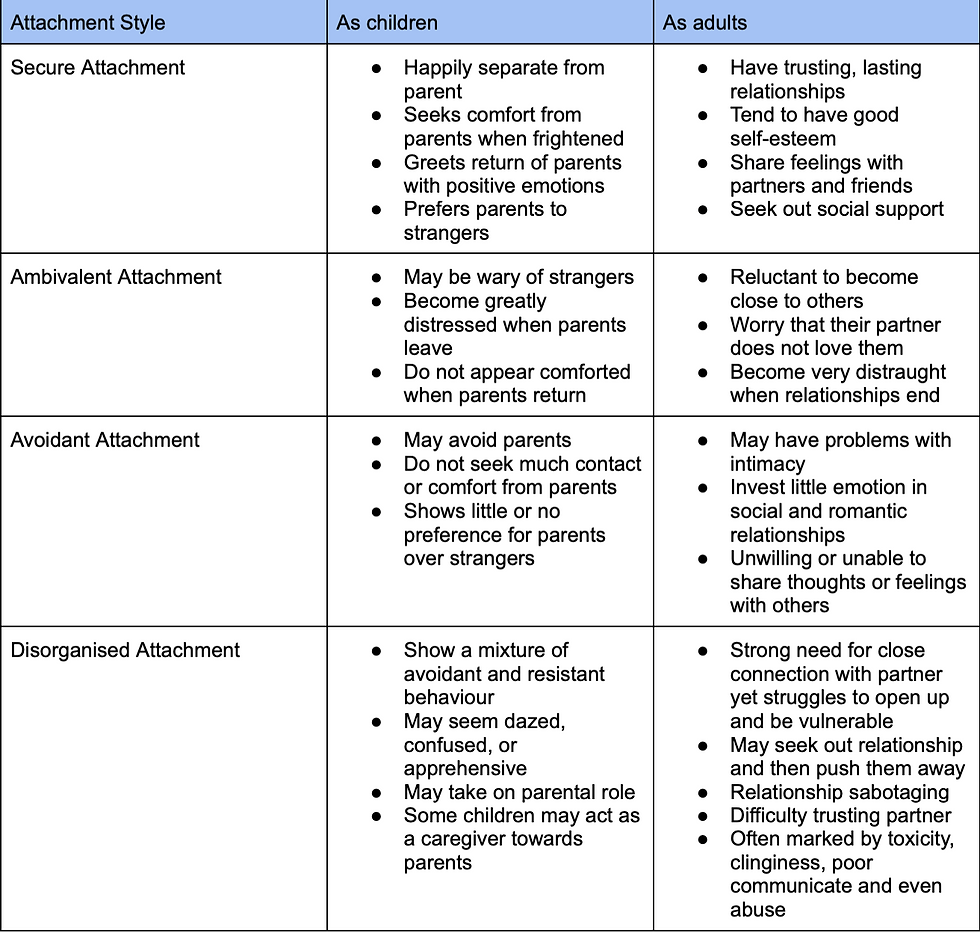Anxiety in Relationships
- The BRO Program

- Jul 9
- 3 min read
Relationship anxiety can cause you to experience persistent fear, worries or doubts about your romantic relationships - even if your relationship is going well.
Signs that may indicate that we have relationship anxiety:

*It’s important to note that many of these signs can overlap with signs of abusive relationship. Nelow are two perspectives that indicate that relationship anxiety and potentially abusive relationships:
You have relationship anxiety due to your attachment style (see below). When you were a child, your emotional needs may not have been met by your parent(s), so you may require extra reassurance or have a different perspective on what a healthy relationship looks like. This can be worked on by communicating with your partner to create a healthy and stable attachment style. It is difficult to change the attachment style that has been developed, but in a healthy relationship this can be done. There is a key focus on you being open and honest with your partner, exploring where these behaviours might have come from, and creating healthy boundaries and expectations for your relationship. This means you can both feel comfortable and safe, without the need for constant reassurance or communication, promoting independence.
If your partner displays these signs and it is causing you stress, this could be a sign that you are in an unhealthy relationship. It doesn’t mean this can’t be fixed with communication, but the clear difference would be if your partner is willing to value your expectations of a relationship and needs as a partner and an individual. Suppose your partner wants to create a healthy, safe, communicative relationship with you. In that case, they will be able to listen to and value your concerns that this relationship doesn;t feel healthy to you, and can work with you to make it better. If they don’t want to change their behaviours, and it feels stressful, controlling or manipulative in nature, then this could be an unhealthy or potentially emotionally abusive relationship. Some additional signs could be guilting you to do things you don’t want to do, or to cancel plans that you had without them. It can manifest as possessiveness or obsessive behaviour that feels controlling. If you feel safe and able to communicate your concerns with your partner and they will work with you to create a healthier relationship, this may not have been abusive but may be unhealthy and a display of relationship anxiety (Reason 1)
Attachment styles
Understanding the key differences in attachment styles and how they develop, can help us learn how to begin developing a secure and stable attachment with our partners.
John Bowlby developed extensive research into attachment styles, and believed that there are four distinguishing characteristics of attachment:
Proximity maintenance: the desire to be near the people we are attached to
Safe haven: returning to the attachment figure for comfort and safety in the face of a fear or threat
Secure base: the attachment figure acts as a base of security from which the child can explore the surrounding environment
Separation distress: anxiety that occurs in the absence of the attachment figure
Mary Ainsworth expanded on this by creating four attachment styles:

So how do we create healthy and secure attachments in our relationships as an adult?
Examine your beliefs about relationships:
It is important to investigate what is actually true about your current relationships and abandon outdated beliefs and interpretations.
Act opposite to your other attachment style:
Try taking small steps toward becoming more independent. The goal is to find a healthier balance between intimacy and independence. It isn’t easy to change this and it won’t be overnight, but living with no relationship anxiety is a huge reward.
Address past attachments:
If possible, seeking talking therapies to explore childhood relationships or relationship trauma can help you challenge core beliefs and patterns that have been repeated in your current relationship and how to overcome those.
Build self-confidence:
Promote your own independence and confidence as an individual outside of your relationship by reminding yourself of personal strengths and achievements. Spending time building hobbies and socialising outside of your relationship can help to build a healthier relationship
Practicing healthy communication:
Express your needs and feelings directly, and be curious about your partner’s views, perspectives and boundaries. Remember you’re both wanting to work together to build a healthy relationship, you’re not working against each other.
Be vulnerable and consistent:
Begin opening up about your emotions slowly so as not to overwhelm your partner, and be consistent in your actions to promote a healthy relationship.




Comments